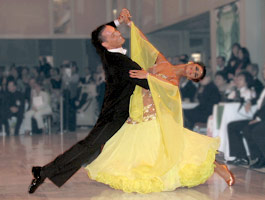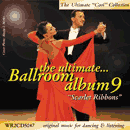Learn to Dance: Waltz

The beautiful, graceful Waltz
History of Waltz - During the eighteenth century (around 1750), while society's upper class enjoyed dancing the Minuet, the peasants of Bavaria began dancing a dance for couples, called the Walzer.
As the Bavarian folk dances transitioned from countryside to the suburbs of the city, the stomping-style of the dances developed into a smooth, sliding step with gliding rotation.
It was the first time on the dance floor where a man held the woman with his arm wrapped around the lady's waist, so intimately close. This new hold was considered immoral and was met with strong criticism. Despite shocking many when it was first introduced, the Waltz became fashionable in Vienna around the 1780s. The Waltz was later introduced to the world of ballroom dancing in the early 1800s.
In Vienna, during the 1830s, two composers, Franz Lanner and Johann Strauss, wrote inspiring melodies that would further promote the popularity of the Waltz. These faster melodies were quite demanding, as the man would Waltz his partner from one end of the hall to the other with great speed.
The Waltz finally made its way to the United States around the 1850's. During the latter part of the 19th Century, composers began writing Waltzes to a much slower tempo as a counterpart to the demands of the faster "Viennese" Waltz style. This slower tempo came into prominence in the early 1920s.
The Waltz, and especially its closed position, became the example for the creation of many other ballroom dances. Today we have two distinctive tempi with varied accented beats and dance styles, the fast tempo for Viennese Waltz, and the slower tempo for "slow" Waltz.
Music and Tempo - The "slow" Waltz music is written in 3/4 time and should be played at a tempo at 28-30 measures per minute. The following rhythm is used: Q,Q,Q (1,2,3 - 1,2,3...)
Style - The Waltz is a traveling and turning dance moving along the Line of Dance. It's movement is characterized by the use of Sway and "Rise and Fall", accompanied by leg and body swing. The progressive style figures of the Waltz are designed for larger dance floors.
| Step | Rhythm & Beats |
Foot Movement |
Footwork | Amt of Turn |
Dance Position |
|---|---|---|---|---|---|
| 1 | Q-1 | LF fwd | HT | Optional- Up to 1/2 turn to left over steps 1-6 |
Closed Dance Position throughout |
| 2 | Q-2 | RF side | T | ||
| 3 | Q-3 | LF close | TH | ||
| 4 | Q-1 | RF bk | TH | ||
| 5 | Q-2 | LF side | T | ||
| 6 | Q-3 | RF close | TH | ||
| Definitions - Click here | |||||
| Step | Rhythm & Beats |
Foot Movement |
Footwork | Amt of Turn |
Dance Position |
|---|---|---|---|---|---|
| 1 | Q-1 | RF bk | TH | Optional- Up to 1/2 turn to left over steps 1-6 |
Closed Dance Position throughout |
| 2 | Q-2 | LF side | T | ||
| 3 | Q-3 | RF close | TH | ||
| 4 | Q-1 | LF fwd | HT | ||
| 5 | Q-2 | RF side | T | ||
| 6 | Q-3 | LF close | TH | ||
| Definitions - Click here | |||||

 Online Music Store
Online Music Store